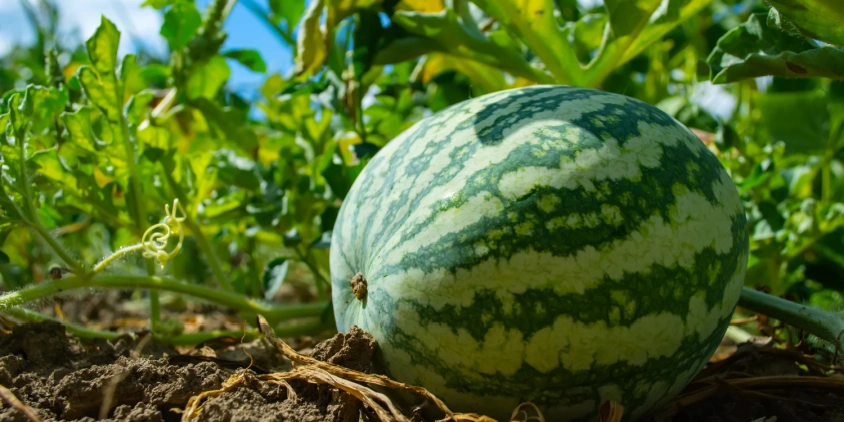
Growing Watermelon: Pro Tips For High-Yield Farming
Growing watermelon, thanks to the fruit’s year-round popularity, is no longer limited to the summer months for farmers blessed with suitable land. The optimal growing conditions for watermelon farming include somewhat sandy soils that drain well, lengthy periods of sunshine, and plenty of heat. During the growing season, crops don’t need much attention, but they do use a lot of resources, such as water and nutrients, to produce juicy, sweet fruits. With the help of precision agriculture technologies, crop producers can minimize financial and environmental strains while growing high-yielding, luscious watermelons.
Optimal Watermelon Growing Conditions
The three top requirements for watermelons to grow well are enough sunshine, water, and space. Soils that drain well and are rich in nutrients are also essential for nurturing good fruit.
Watermelon Sun Requirements
Optimal crop growth and production of the sweetest fruits require full sun, ideally 8 to 10 hours per day. Sunny weather is particularly important during the flowering stage, not only to support flower appearance and development but also to stimulate honey bee pollination activity.
A growing watermelon plant can handle light shade to a certain extent, especially in hotter growing regions, but it still needs lots of sunshine to produce sugar. If the area is too shaded, the fruit might grow smaller and fewer than average. On the other hand, excessive exposure to direct sunlight can cause heat stress on vines.
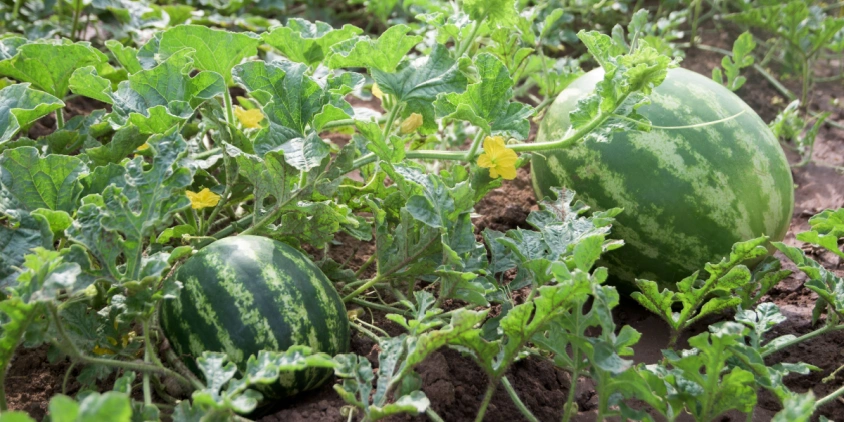
Watermelon Growing Temperature And Humidity
The crop grows in long, hot summers with daytime temperatures ranging from 70 to 85°F (21 to 29°C), though it can tolerate temperatures as high as 90°F (32°C). Frost is fatal to the crop, so don’t start planting until the risk of frost has gone. Low temperatures below 50°F (10°C) or high temperatures above 95°F (35°C) will retard the watermelon’s growth and harvest time.
Good soil drainage is more important than humidity during most of the growing season. However, during the flowering stage, the relative humidity levels are crucial, with an optimal range of 60–80%.
The crop, originally from the tropics and subtropics, grows best in sunny, warm climates with relatively high humidity. Given sufficient warmth, it can also be successfully cultivated in temperate climates.
Even in the most dispersed and remote growing regions, EOSDA Crop Monitoring can give you comprehensive historical weather records for your fields. Accurate weather data can guide well-informed decisions to achieve optimal yields. If you’re an agricultural consultant using our remote farm monitoring solution, you might, for instance, advise your clients on where to grow watermelons for maximum harvest. Crop producers can now link their Davis stations to our platform and view their data to obtain field-specific forecasts and examine weather effects on field vegetation.
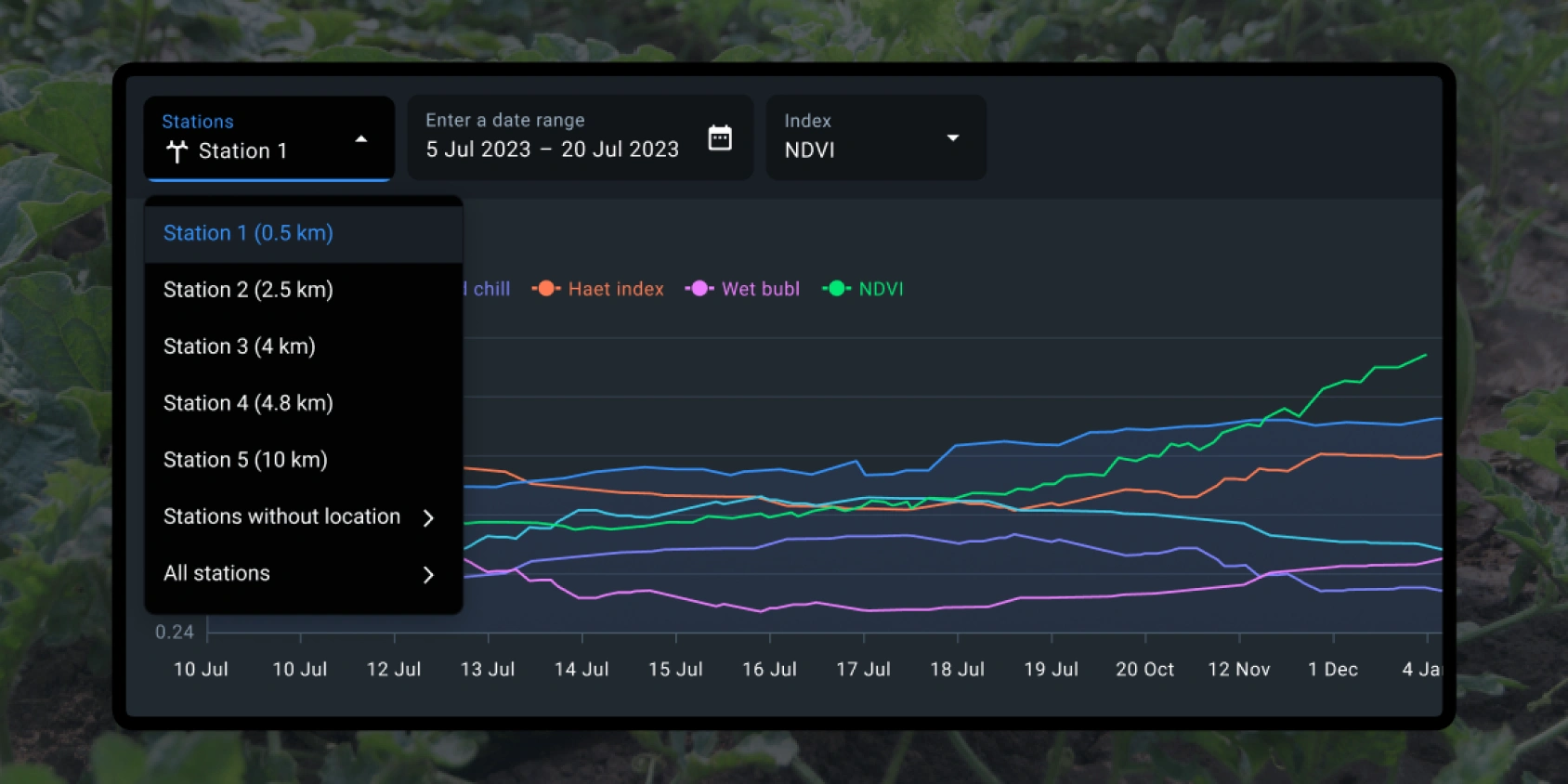
Best Soil For Growing Watermelons
The crop, with its high nutritional demand, will grow best in nutrient-rich and fertile soils. The crop will thrive in almost any soil that drains effectively, yet sandy loam is ideal for growing. Soils that are overly clay-rich and, thus, poorly draining can be problematic for growing these plants.
There is a strong relationship between soil pH and plant development and yield because soil pH affects the plant’s ability to access nutrients. Watermelons prefer acidic soils (pH levels ranging from 6.0 to 6.5). The ideal soil pH for growing the crop can be achieved with the use of soil amendments.
The Essentials Of Watermelon Planting
You can grow watermelons from seed or use transplants. Direct sowing is more cost- and labor-effective. However, transplanting allows for more precise management of plant populations and expedites harvest time.
How To Prepare The Soil For Watermelon
To prepare the field for planting watermelons, first clear it of any debris and rocks. Next, break up large clumps and aerate the soil by tilling it to a depth of 12–15 inches (30–38 cm). To enhance soil structure, incorporate compost or aged manure. Amend the soil with lime to neutralize acidity and improve nutrient availability for the growing crop. After completing these operations, water the field and let the growing medium become slightly warmer and drier before planting watermelons.
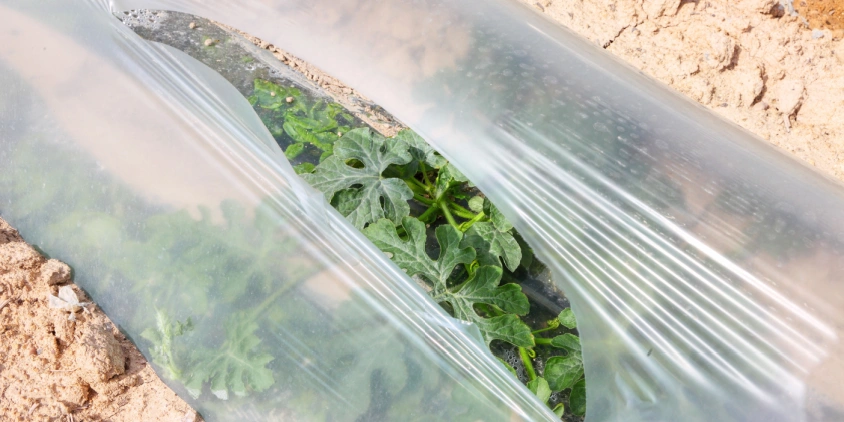
When To Plant Watermelon
Wait until the soil warms up enough to ensure seed germination. The minimum soil temperature for planting watermelon is 65°F (18°C). Soil solarization, which involves covering the soil with black plastic mulch, can help speed up ground warming. Make sure you check the weather records and forecasts for your growing region to determine when the last frost will occur and wait at least two weeks beyond that date to avoid frost damage.
In cold growing regions, plant seeds indoors 2–3 weeks before the last predicted frost, whereas in warmer growing regions, direct seeding is a way to go. Don’t rush time to plant watermelons, since seeds planted too early might take longer to germinate and produce uneven stands.
How To Plant Watermelon
Homogenous, disease-free, certified seed with a germination rate of 85–90% is required for growing the crop commercially . The desired fruit size dictates the watermelon planting spacing. The standard recommendation is 24–30 square feet (2.2–2.8 square meters) per plant for growing crops with larger fruits. Normal spacing between rows is 6 to 8 feet (1.8 to 2.4 m), with plants 42 to 60 inches (100 to 150 cm) apart. Small-sized fruits require less growing space, typically 13 to 14 square feet (4 to 4.2 square meters) per plant.
The planting depth for watermelons should be about 1 inch (2.5 cm).
Farmers looking for a head start might consider growing watermelons from transplants. In areas with a short growing season, transplants are preferred since they reach maturity around two weeks earlier than seeded plants.
With the user-friendly interface of our digital agriculture platform, you can smoothly plan planting-related fieldwork and other field activities. Add and edit details such as sowing rates, workers in charge, and time frames with ease. If you have multiple fields, you can sort them by crop or any user-defined categories and check field activity records at any time.
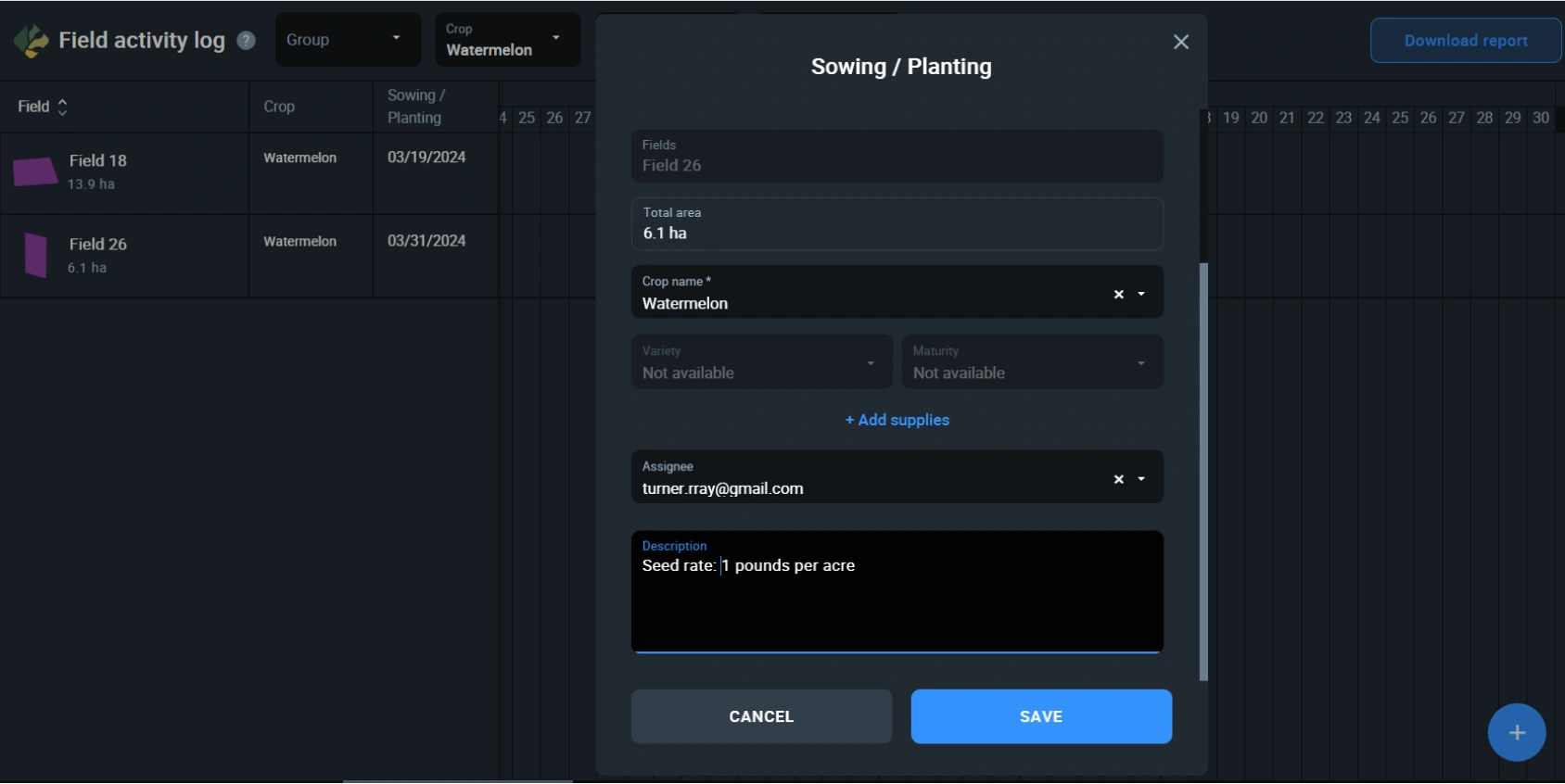
EOSDA Crop Monitoring
Using satellite monitoring for remote fields management in one platform!
How To Care For Watermelon Plants
To promote fruit set and yield, farmers should sufficiently water and fertilize crops throughout the growing season. Pruning and timely removal of underdeveloped fruits allow the production of marketable-sized harvestable melons.
Fertilizing Watermelons
For commercial watermelon farming, apply 120 lbm/ac (134 kg/ha) of nitrogen (N), phosphorus (P), and potassium (K) fertilizers at maximum. Heavy rain and sprinkler irrigation can wash away nutrients, especially mobile ones like N and K. It is best to split these nutrients into several applications to minimize the risk of fertilizer burn and leaching losses. Because P is immobile, you can apply it once before planting, and it will remain available throughout the growing season.
Many growers choose to apply all of the phosphorus and potassium at once, while splitting the nitrogen application into two parts: half before planting and the other half later in the growing season, 4–6 weeks after planting. More advanced methods, such as the modified broadcast, involve dispersing fertilizer in bands 2 to 3 feet (0.6 to 0.9 m) wide before watermelon planting. This method delivers nutrients directly to the plant’s root zone and protects growing seedlings from burning.
Regardless of your fertilization method, EOSDA Crop Monitoring’s VRA maps will help you save inputs and keep fertilizer from running off your fields. By integrating satellite-derived data with vegetation indices, our technology generates multi-zone maps spanning sparse to dense vegetation. This way, you can pinpoint particular areas of the field where the watermelon vines are not growing quickly enough — possibly due to nitrogen deficiency — and adjust the fertilizer amount applied there accordingly.
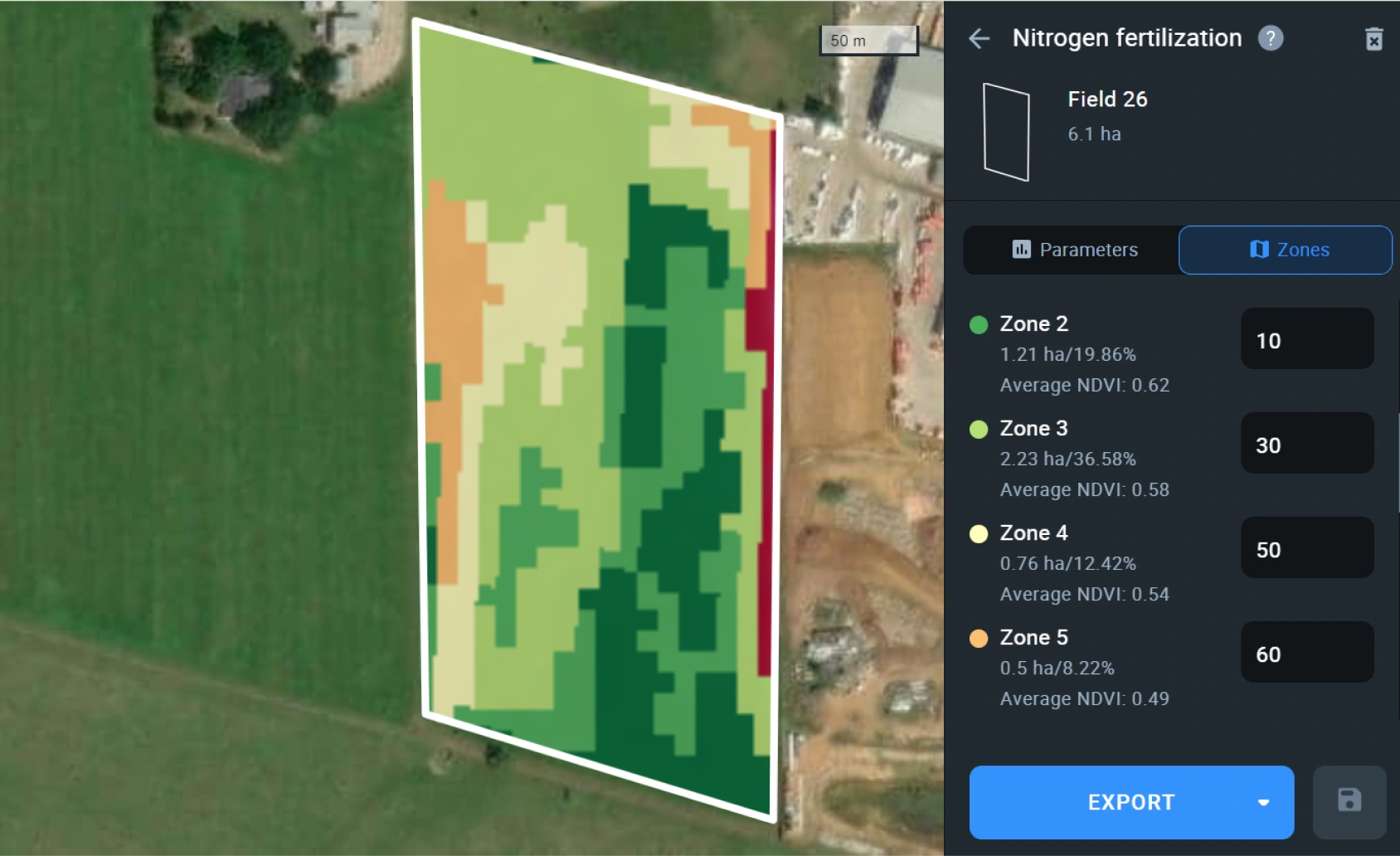
Watering Watermelon Plants
Watermelon vines are particularly vulnerable to drought stress between planting and the onset of fruit development. Make sure to water your growing plants more frequently if it doesn’t rain enough during this time. Maintain a somewhat moist, but not soggy, growing medium condition.
Typical watermelon water requirements are 1–2 inches (25–50 mm) per week.
Before irrigating watermelons, check the field-specific forecast in EOSDA Crop Monitoring. If heavy rain is anticipated, you won’t need to water further. On the other hand, during heat waves that pose a high drought risk, you have to support growing watermelon plants with sufficient irrigation.
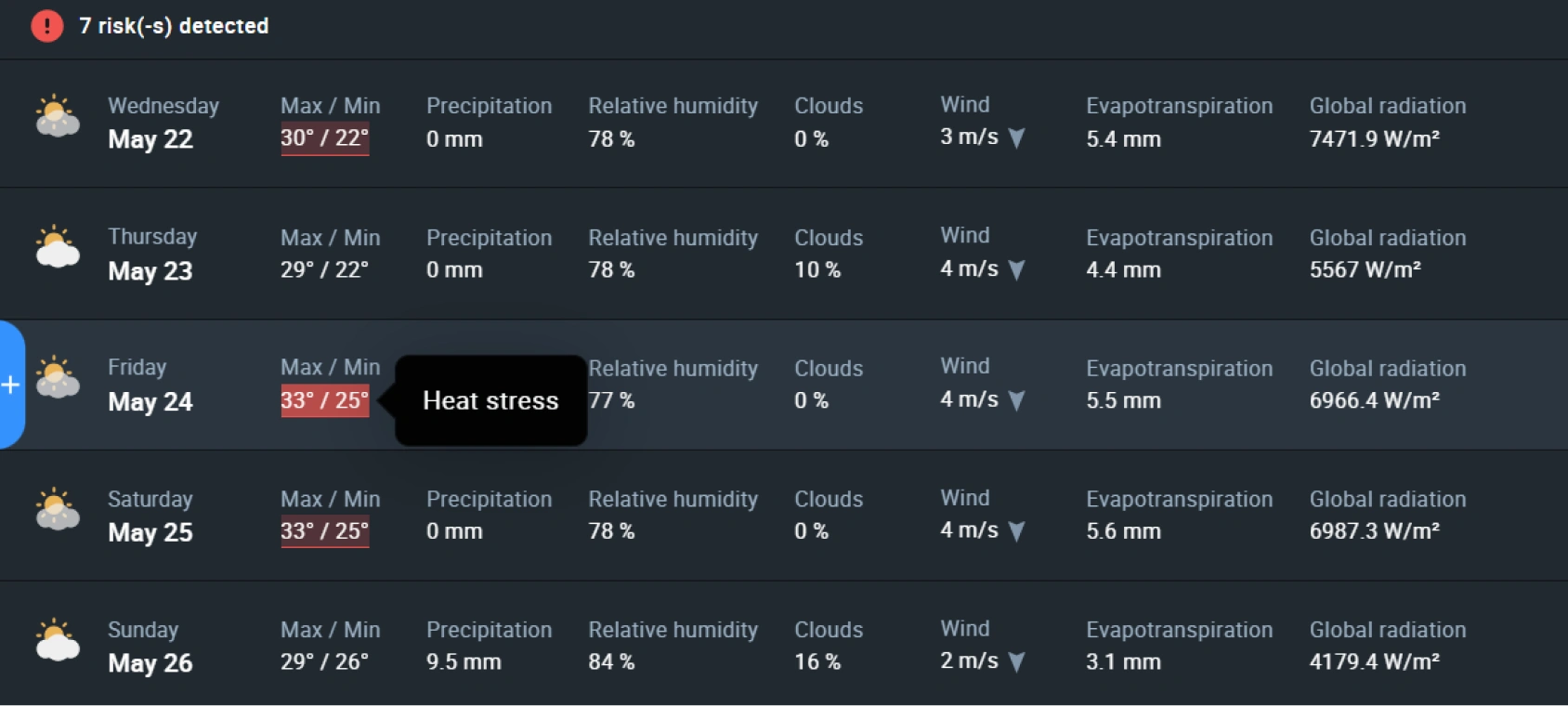
Instead of using sprinklers, invest in a soaker or drip irrigation system to hydrate your growing crops. Delivering moisture straight to the plant’s root zone helps prevent most pathogenic fungi from growing and spreading. Irrigating your crops first thing in the morning gives the leaves plenty of time under the sun, which also helps to keep fungus at bay.
Control Of Watermelon Pests And Diseases
Throughout the watermelon growing season, pests and diseases may attack any part of a plant. By making melons more susceptible to sun-scald and, by extension, less flavorful, foliar diseases lower fruit quality. Pests and diseases that damage fruits often render them unmarketable. Thankfully, early detection allows for effective pest and disease management.
| Pest/Disease | Symptoms |
|---|---|
| Aphids |
|
| Cucumber beetles |
|
| Root maggots |
|
| Powdery mildew |
|
| Fusarium wilt |
|
| Watermelon mosaic virus |
|
| Downy mildew |
|
| Anthracnose |
|
| Fruit blotch |
|
| Gummy stem blight |
|
Remote monitoring, particularly the Disease risk feature in EOSDA Crop Monitoring, plays an important role in detecting crop diseases early on. Scouts, who have the expertise to identify and assess specific symptoms on-site precisely, will gather further information to guide control strategies.
Pruning Watermelon
Pruning watermelon vines promotes a healthier crop and larger fruits. Though this operation is not strictly necessary, preventing lateral vines from growing and attaching to the main vine may increase vine productivity.
When the crop is still young, remove the terminal buds as they emerge. Inspect the plant for any underdeveloped, irregular, or decaying fruit and remove it. By pruning bad fruits, you can redirect the plant’s resources toward growing larger and juicier melons.
How Long Does It Take For Watermelon To Grow?
Growing watermelons is not the quickest of all crops. Depending on the variety, watermelons need 70–100 days to grow. While it’s not always the case, smaller varieties tend to grow faster, in around 70 to 75 days. Main-season varieties are typically larger and have a longer growing season, lasting between 80 and 90 days. To reduce time-to-maturity by about 2 weeks, instead of starting with seeds, use plant transplants, already up and growing.
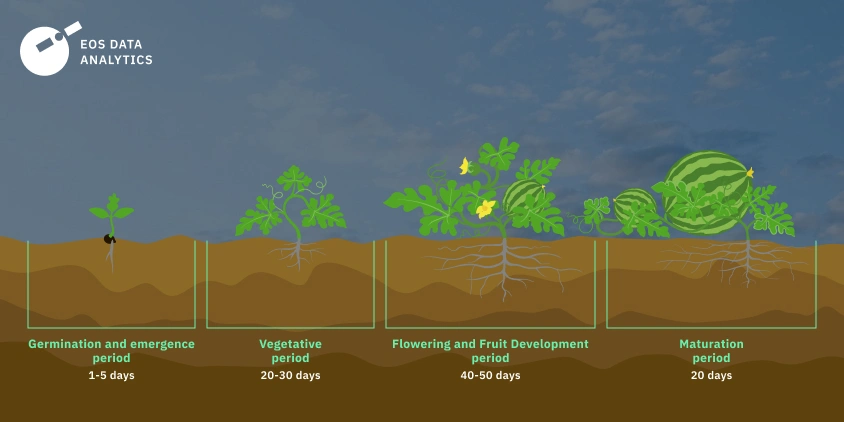
Harvesting And Storing Watermelon Fruits
When picking watermelons, wait till they are ripe. Next, carefully cut the fruits from the vines and transport them to a cool storage area to maintain their peak quality.
When To Harvest Watermelon
Removing the immature fruits from the vine prevents them from ripening, so wait until the melons grow completely ripe before picking them. However, watermelon harvest time might be tricky to pin down. The part of the ripe fruit that touches the ground will typically become yellow instead of creamy white; however, this depends on the variety. Here are several other fairly dependable clues that can help you gauge when the fruit is ripe:
- the curly tendril, connected to the stem, becomes dry and brown;
- the rind hue shifts from glossy to matte;
- the rind becomes difficult to penetrate with the fingernail;
- the blossom end softens.
Although these signs are helpful, cutting a watermelon is still the best way to tell if it’s ripe.
It usually takes about two weeks for all the watermelons growing in the field to ripen. When one fruit ripens, the others will shortly follow suit.
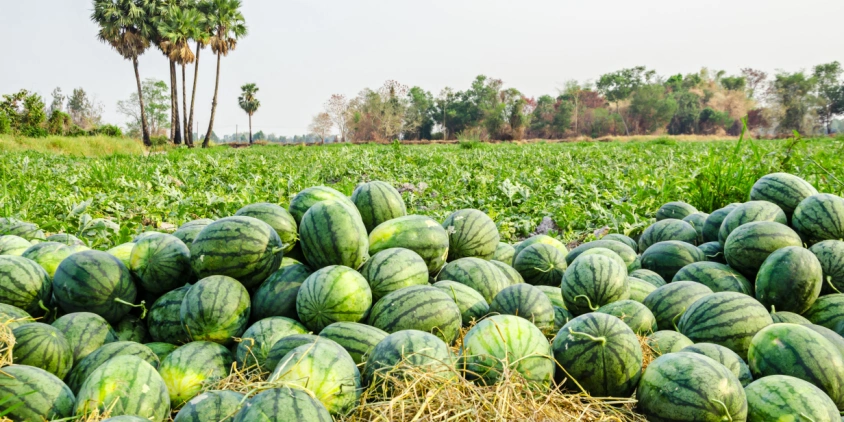
How To Harvest Fruits
Watermelons are manually cut from the vine using a sharp knife. Cutters should be extremely careful not to skin or scuff fruits. To avoid rind abrasions and rotting, harvesting watermelons occurs only in dry weather. After removing melons from the vines, it is important to turn their bottoms down so they don’t become sunburned.
For safe transportation to storage facilities, fruits should be carefully placed in trucks padded with a soft cloth and lined with hay or straw at the bottom. Regularly replace the bottom lining to avoid sand accumulation and potential damage to the fruits’ rinds.
How To Store Fruits
Temperature control is essential for keeping fruit in peak-quality condition and extending its shelf life. The range of 50–60°F (10–16°C) is considered optimal for storing watermelons, with 55°F (13°C) being the sweet spot .
Watermelons are susceptible to chilling injury at temperatures below 50°F (10°C), which can lead to internal flesh redness reduction and juice leakage, as well as surface pitting, tissue necrosis, and dark spots on the rind. Fruits that were bruised before being chilled will also develop flesh discoloration when brought to room temperature. Instead, by following key tips for growing, harvesting, and storing watermelon, crop producers can get their hands on the best, most in-demand fruit.
About the author:
Vasyl Cherlinka is a Doctor of Biosciences specializing in pedology (soil science), with 30 years of experience in the field. He attended the engineering college in Ukraine and received his degree in agrochemistry, agronomy and soil science in the Chernivtsi National University. Since 2018, Dr. Cherlinka has been advising EOSDA on problems in soil science, agronomy, and agrochemistry.
Recent articles

Analyze 2025 & Plan Your Best Year Yet: LandViewer Christmas Offer
It’s the most wonderful time of the year! The Christmas holidays are here, and so is your chance to analyze 2025 and plan a prosperous 2026 with more affordable Pro plans in LandViewer.

EOSDA Models Climate Change Impact On Sugarcane Yields
EOSDA modeled future temperature, rainfall, and other climate impacts on Veracruz sugarcane. The results help growers plan long-term adaptation strategies, including timing, varieties, and irrigation.

EOSDA LandViewer Black Friday Sale: Exclusive Offers & Giveaway
This Black Friday, LandViewer offers new users the chance to save on monthly plans, get extra months with yearly subscriptions, and participate in a free annual plan giveaway.